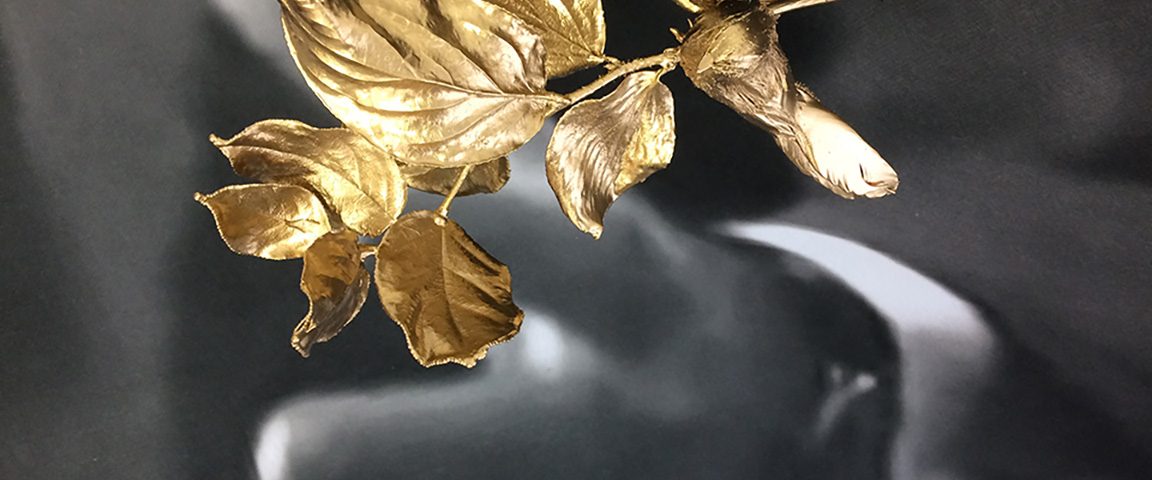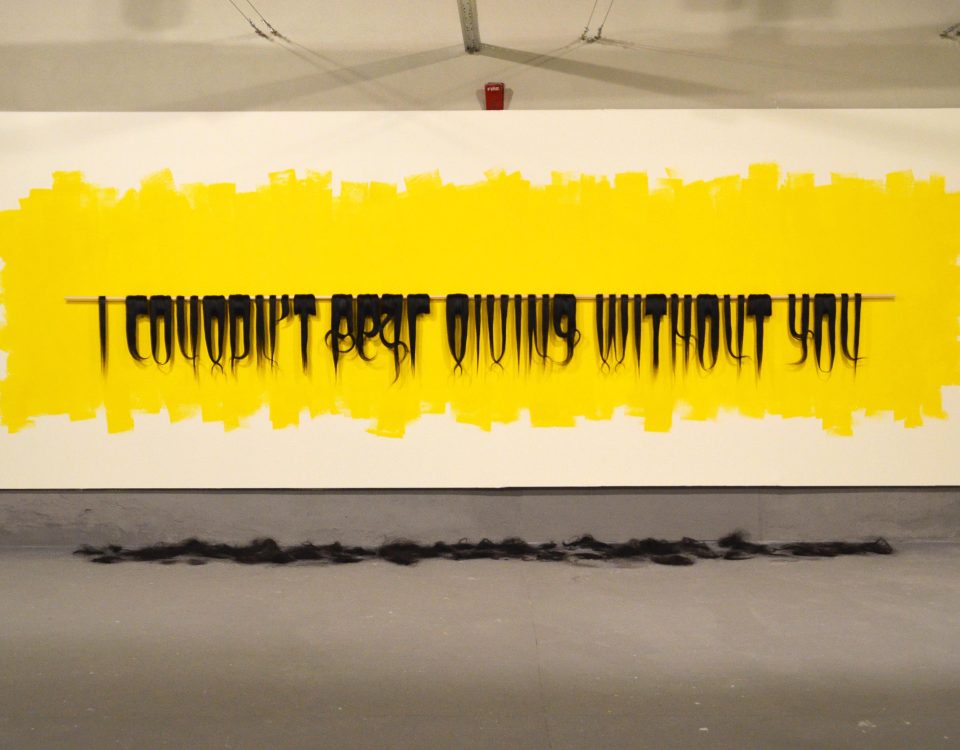What I was expecting had to happen 2017
Print on felt, aluminium sheet, 1,50 x 0,90 m. Real gilt branch and bird 27 x 20 x 17 cm.
The work What I was expecting had to happen deals with the relationship between the creator and his creation, the emotional fluctuations through the complex relationships of desire and guilt. More specifically, it acrobats between the biography of the Serbian author Mesa Selimovic (1910–1982) and the fictional content of his book Death and the Dervish, a groundbreaking novel of 20th century Yugoslavian literature.
Maria Tsagkari's “What I was expecting had to happen” (2017) is a piece focusing on gestures: the obvious one, as presented on her artwork’s iconography, but also an invisible one. On a first level, we see the hands of the Serbian author Mesa Selimovic. Tsagkari’s work begins from the author’s 1968 interview scene, on national TV, focusing the exact moment when Selimovic confesses that both his guilty syndrome and the severe psychological trauma caused by his political ideology, became finally words after 20 years (that is, the book which made him a famous writer). However, in a second interpretation of this situation, a small detail in the content of this book, the scene where his only friend gives him a poetry book (with a leather cover and embroidered four birds on every corner) is the second “hidden” gesture, due to which the author declared that he regained his faith in humans; even if he is then imprisoned, tortured and eventually crushed by his own faith.
Areti Leopoulou, Art historian – curator
The work has been presented in the exhibitions: Higher by Spinning, 33rd International Festival of Sarajevo, curated by Jessy Theo Rahman, Sarajevo.
THREAD, curated by Areti Leopoulou, Kalfayan Galleries, Athens, Greece.
What I was expecting had to happen 2017
Εκτύπωση σε τσόχα, φύλλο αλουμινίου, χρυσή βαφή, 1,50 x 0,90 μ. Επιχαλκωμένο φυσικό κλαδί και πουλί 0,27 x 0,20 x 0,17 μ.
Το έργο What I was expecting had to happen αφορά τη σχέση ενός δημιουργού με το δημιούργημά του, τις συναισθηματικές διακυμάνσεις μέσα από τις πολύπλοκες σχέσεις επιθυμίας και ενοχής. Πιο συγκεκριμένα ακροβατεί μεταξύ της βιογραφίας του Σέρβου συγγραφέα Mesa Selimovic (1910-1982) και του μυθοπλαστικού περιεχομένου του βιβλίου του Ο Δερβίσης και ο θάνατος, ένα μυθιστόρημα καμπή στη λογοτεχνία της Γιουγκοσλαβίας του 20ου αιώνα.
Το έργο της Μαρίας Τσάγκαρη “What I was expecting had to happen” (2017) εστιάζεται στις χειρονομίες: την καταφανή που απεικονίζεται στο έργο της αλλά και μία αφανή. Σε ένα πρώτο επίπεδο, βλέπουμε τα χέρια του Σέρβου συγγραφέα Mesa Selimovic. Αφορμή, άλλωστε για το έργο της αποτελεί μια τηλεοπτική στιγμή από συνέντευξή του το 1968, ακριβώς όταν ο συγγραφέας ομολογεί ότι το ενοχικό του σύνδρομο και το βαρύτατο ψυχικό τραύμα που του προξένησε η πολιτική του ιδεολογία, μετά από 20 χρόνια έγιναν λέξεις –δηλαδή το βιβλίο που τον έκανε διάσημο συγγραφέα. Ωστόσο, σε μια δεύτερη ανάγνωση, μια μικρή λεπτομέρεια στο περιεχόμενο του βιβλίου αυτού, η σκηνή-στιγμή κατά την οποία ο μοναδικός του φίλος τού χαρίζει το βιβλίο ενός ποιητή (με δερματόδετο εξώφυλλο και κεντημένα τέσσερα πουλιά σε κάθε γωνία), αποτελεί την δεύτερη και αφανή χειρονομία, χάρη στην οποία ο συγγραφέας δηλώνει πως επανάκτησε την πίστη του στον άνθρωπο ακόμη κι αν κατόπιν φυλακίζεται, βασανίζεται και εντέλει συνθλίβεται από την ίδια του την πίστη.
Αρετή Λεοπούλου, Ιστορικός τέχνης, επιμελήτρια.
Το έργο παρουσιάστηκε στις εκθέσεις: Higher by Spinning, 33rd International Festival of Sarajevo, επιμέλεια Jessy Theo Rahman, Sarajevo.
THREAD, επιμέλεια Areti Leopoulou, Kalfayan Galleries, Athens, Greece.







